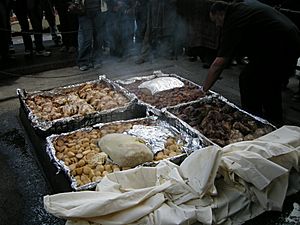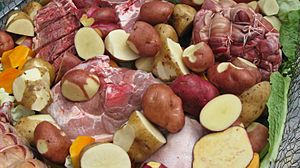Hāngī facts for kids
Hāngī (pronounced hah-ngi) is a traditional New Zealand Māori way of cooking. It uses heated rocks buried in a pit in the ground. This pit is called an umu. Hāngī is still used today for large groups of people on special occasions. It lets you cook a lot of food without needing big kitchen appliances.
Contents
How a Hāngī is Made
To "lay a hāngī" or "put down a hāngī" means to prepare this special meal. First, a pit is dug in the ground. Then, a big fire is made in the pit to heat stones. After the stones are hot, baskets of food are placed on top of them. Everything is then covered with earth for several hours. Later, the hāngī is uncovered, or "lifted." People who are experts at hāngī have improved these methods over many generations.
What Foods Go in a Hāngī?
Many different foods can be cooked in a hāngī. Popular meats include lamb, pork, chicken, and seafood. Seafood is called kaimoana in Māori. Vegetables like potato, kūmara (which is sweet potato), yams (also known as oca), pumpkin, squash, taro, and cabbage are also common.
Preparing the Pit and Stones
A hāngī pit is usually dug about 50 to 100 centimeters (20 to 40 inches) deep. This is deep enough to hold the rocks and two layers of food baskets. Logs, often from mānuka or kānuka trees, are stacked over the pit. Rocks, usually strong types like andesite or basalt, are placed on top of the logs.
The logs are lit and burn for about 3 to 4 hours. This heats the rocks to a very high temperature, around 600 to 700 degrees Celsius (1100 to 1300 degrees Fahrenheit). Once the fire has burned down, the hot ashes are mostly removed. Sometimes, the fire is built separately. Then, the hot rocks are moved into the pit.
Cooking the Food
While the rocks are heating, the food is made ready. It is placed into wire baskets. These baskets are lined with leaves like puka, banana, or cabbage leaves. Sometimes, aluminum foil is used instead.
The basket with meat goes into the bottom of the pit. The vegetable basket is placed on top of the meat. If seafood is part of the meal, it goes on top of the vegetables. Wet sacks or cloth are put over the baskets. Finally, the whole pit is covered with earth.
The hāngī cooks for about 2.5 to 4 hours. Someone usually watches the hāngī while it cooks. They make sure to cover any steam that escapes with more earth.
Lifting the Hāngī
Once the hāngī is cooked, the earth is carefully removed from the top of the pit. Then, the sacks or cloth are taken off. The baskets are lifted out of the pit. The delicious food is then taken to the kitchen to be cut and served.
Changes Over Time
Long ago, before metals were common, food was placed between bark, large leaves, and other plants. Wire baskets became popular in the early 1800s. Sacks and cloth then replaced leaves and bark for covering the hāngī.
Today, some people use "hāngī machines" made of stainless steel. These machines are heated by gas. They try to cook food in a similar way to a traditional hāngī, but without needing a wood fire, rocks, or a pit.
Early Umu-tī Cooking
Evidence from early Polynesian settlements in New Zealand, like Wairau Bar, shows very large cooking pits. These pits were called umu. They were designed to cook tī kōuka (cabbage tree) or other types of Cordyline plants.
An umu-tī was much bigger than a normal earth oven. The long, carrot-shaped root of the cabbage tree was cooked in a large, stone-lined pit. This cooking could take one to two days! The cooked root became a sweet, soft pulp. This was a common cooking method in other Polynesian islands too, like the Cook Islands. Studies show that most of these very large pits were used only once or twice.
See also
 In Spanish: Hāngi para niños
In Spanish: Hāngi para niños




